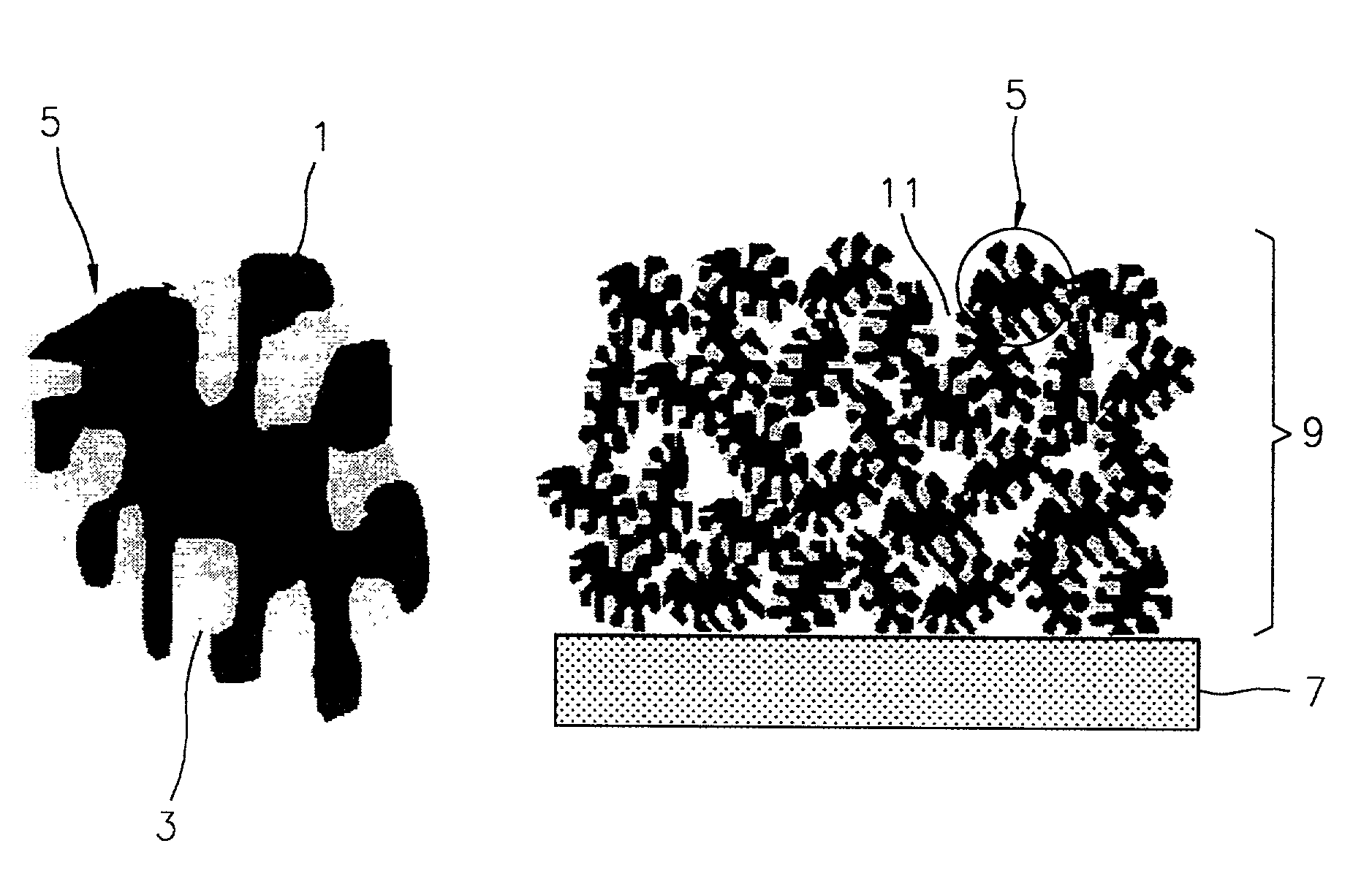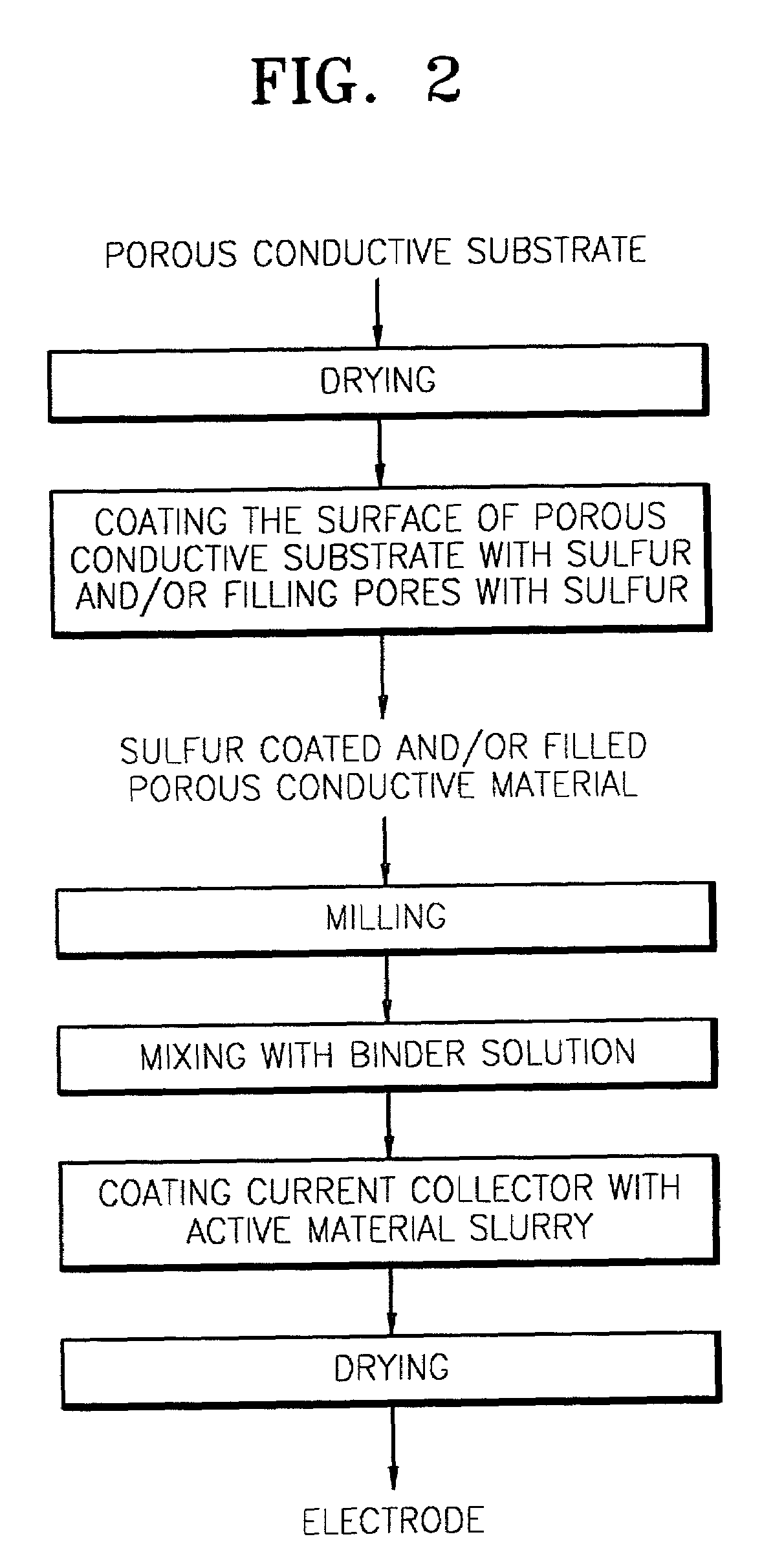Cathode electrode including a porous conductive material coated and/or filled with sulfur and/or a sulfur-containing organic compound and lithium battery containing the same
a technology of porous conductive material and cathode electrode, which is applied in the direction of cell components, final product manufacturing, sustainable manufacturing/processing, etc., can solve the problem of adversely affecting the characteristics of the battery
- Summary
- Abstract
- Description
- Claims
- Application Information
AI Technical Summary
Benefits of technology
Problems solved by technology
Method used
Image
Examples
example 1
Preparation of Sulfur Filled Porous Conductive Material
[0070]Powdered, coal-based active carbon having a specific surface area of 800 m2 / g (see SEM photograph shown in FIG. 3) was vacuum dried at 180° C. for 22 hours. During this process, water was removed, reducing the weight by 2.6%. Dried active carbon (8.05 g) and 8.03 g of a sulfur monomer were loaded into separate containers. These containers were placed in a sealed container and allowed to stand at 180° C. under atmospheric pressure for 20 hours, thereby preparing a porous conductive material filled with 15.4% by weight of sulfur relative to the weight of the active carbon.
example 2
Preparation of Sulfur Filled Porous Conductive Material
[0071]Powdered, coal-based active carbon having a specific surface area of 800 m2 / g (see SEM photograph shown in FIG. 3) was vacuum dried at 180° C. for 22 hours. During this process, water was removed, reducing the weight by 2.6%. Dried active carbon (2.03 g) and 2.06 g of a sulfur monomer were mixed and loaded into a container. This container was placed in a sealed container and allowed to stand at 180° C. under atmospheric pressure for 20 hours, thereby obtaining a porous conductive material filled with 66.5% by weight of sulfur relative to the weight of the active carbon. An SEM photograph of the obtained sulfur filled porous conductive material is shown in FIG. 4. When compared to FIG. 3, FIG. 4 shows that pores of the active carbon are filled with sulfur.
example 3
Manufacture of Cathode Electrode
[0072]Powdered, coal-based active carbon having a specific surface area of 800 m2 / g (see SEM photograph shown in FIG. 3) was vacuum dried at 150° C. for 72 hours. During this process, water was removed, reducing the weight by 2.13%. Dried active carbon (16.03 g) and 20.04 g of a sulfur monomer were mixed to be loaded into a container, followed by sealing. While the temperature was maintained at 150° C., the container was alternately allowed to stand under atmospheric pressure and reduced pressure of 150 Torr for each 24 hours, thereby obtaining a porous conductive material filled with 118.5% by weight of sulfur relative to the weight of the active carbon.
[0073]The porous conductive material filled with sulfur (8.03 g), 340.24 g of zirconia balls and 32.11 g of acetonitrile were placed in a 250 ml-HDPE bottle, followed by ball milling at a speed of 240 rpm for 24 hours. A 6% solution prepared by dissolving a binder polyethylene oxide having a weight av...
PUM
| Property | Measurement | Unit |
|---|---|---|
| diameter | aaaaa | aaaaa |
| diameter | aaaaa | aaaaa |
| particle size | aaaaa | aaaaa |
Abstract
Description
Claims
Application Information
 Login to View More
Login to View More - R&D
- Intellectual Property
- Life Sciences
- Materials
- Tech Scout
- Unparalleled Data Quality
- Higher Quality Content
- 60% Fewer Hallucinations
Browse by: Latest US Patents, China's latest patents, Technical Efficacy Thesaurus, Application Domain, Technology Topic, Popular Technical Reports.
© 2025 PatSnap. All rights reserved.Legal|Privacy policy|Modern Slavery Act Transparency Statement|Sitemap|About US| Contact US: help@patsnap.com



